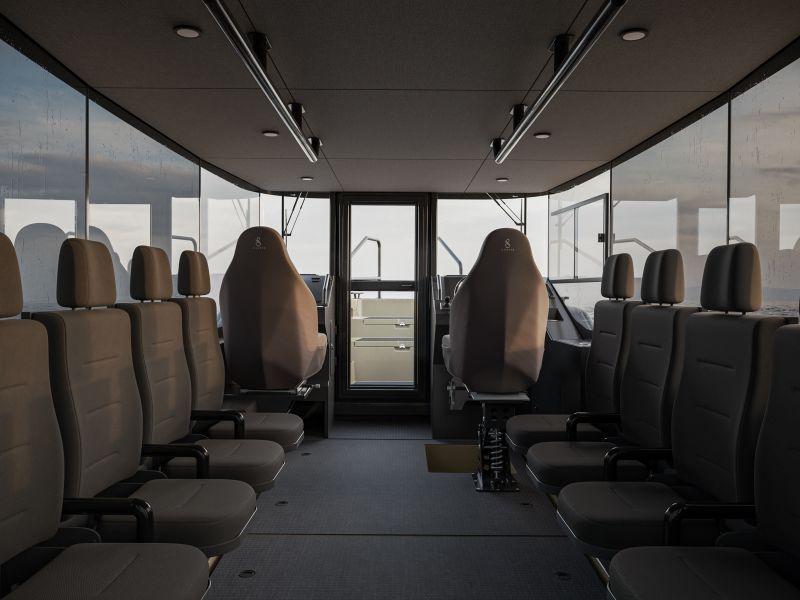
Electric Revolution: Swedish Students Embark on a Maritime Learning Journey

X Shore, a Swedish company, has unveiled a cutting-edge electric workboat for maritime experts This innovative vessel is not only silent but also emits zero emissions, making it the ideal choice for environmentally conscious professionals
In Värmdö, a municipality consisting of 10,000 small islands near Stockholm in Sweden, the school commute is set to become much more thrilling for a select group of students. As of December, the archipelago's four schools will be the inaugural users of the X Shore Pro, a cutting-edge electric boat created by a Swedish manufacturer often referred to as the "Tesla of the seas."
The boat measures 26 feet (8 meters) in length and can accommodate up to 10 passengers. It reaches a maximum speed of 30 knots (about 35 mph) and has a range of approximately 100 nautical miles (about 115 miles), although this is achievable at a lower cruising speed of around 20 knots and is influenced by the load and sea conditions. As a fully electric vessel, it produces zero emissions and minimal noise, resulting in a smoother and more environmentally friendly ride.
Maria Niläng, principal of the Värmdö Archipelago Schools, explains, "We prioritize the well-being of our students and the environment. This innovative electric school shuttle boat not only provides efficient transportation but also promotes a cleaner society and a brighter, healthier future for our students."
âThe Model 3 momentâ
Established in 2019, X Shore had introduced two electric recreational boats, the powerful Eelex 8000 and the compact X Shore 1. The X Shore Pro, designed for commercial use or coast guard purposes, is built upon the former model and incorporates the majority of its features.
Jenny Keisu, Chief Evangelist Officer of X Shore, believes that the reason they are being compared to Tesla is due to the release of the X Shore 1, which allowed for the purchase of a high-performance electric boat at a price comparable to that of a car. She described this as the "Model 3 moment of the boating industry," in reference to Tesla's most affordable car. The X Shore 1 is priced at upwards of â¬109,000 (about $119,000), while the higher-end models in the lineup start at â¬195,000 (about $213,000).
Keisu highlights the radically different experience of riding an X Shore boat compared to a traditional motorboat. Unlike traditional motorboats that emit fumes and noise, X Shore boats are free of such irritants, allowing for a more pleasant and peaceful boating experience.
On board the X Shore Pro.
X Shore
The boat's batteries are comparable to the ones used in electric vehicles, but they are certified for marine use, making them safer around water. They can be charged using normal automotive charging and a supercharger, which takes only 30 minutes, or they can charge at marinas using standard equipment. Charging times for the different models range from two to five hours. It is also possible to charge using a household electric outlet, but this will result in much longer charging times.
The battery problem
Keisu asserts that the charging infrastructure for boats is already in place, as vessels with internal combustion engines also require battery charging for electric systems and onboard appliances. She emphasizes that the only contrast is that X Shore utilizes batteries for propulsion, resulting in larger battery packs. Keisu advocates for a transition to electric vehicles in the boating industry, citing its environmental impact - the average leisure boat emits around four times as much CO2 as the average car.
Boat propulsion using electric power has been around for more than a century, similar to electric cars. Timothy McCoy, an engineering professor at the University of Michigan, points out that battery-based energy storage has also been in use for a long time, receiving use in diesel-electric submarines and cruise ships. Additionally, various types of ships now utilize either hybrid or fully electric propulsion systems.
Technological limitations are currently hindering the electrification of boats, including small leisure boats like those made by X Shore. According to McCoy, the primary issue is the energy density of the batteries, which is a challenge also faced by the automotive industry. Brandon Taravella, an engineering professor at the University of New Orleans, concurs, noting that batteries are too heavy for the amount of energy they provide. He explains that boats and ships are very weight sensitive and would need to carry 40 times the weight of their energy in batteries to match the energy output of traditional fuels, making it costly and design prohibitive.
Boats and ships powered by combustion engines are now facing bans in various lakes and waterways around the world. For instance, Amsterdam will ban diesel and gasoline engines from its canals starting in 2025, and Norway is planning to implement zero emissions requirements for cruise ships, tourist boats, and ferries in its UNESCO World Heritage fjords by 2026.
Keisu believes that taking action in this area could have a significant and rapid impact on reducing CO2 emissions and protecting marine wildlife. He emphasizes the need for politicians and governments to provide support, whether through subsidies or bans, in order for these changes to occur.







